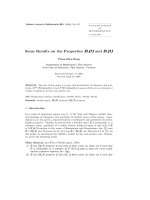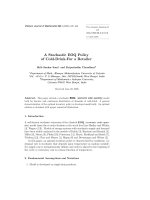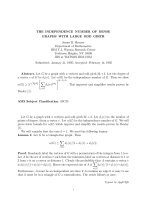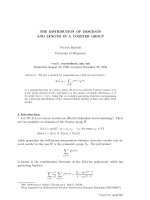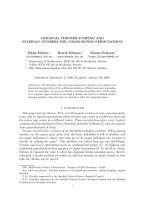Báo cáo toán học: "Ap´ry’s Double Sum is Plain Sailing Indeed e" pps
Bạn đang xem bản rút gọn của tài liệu. Xem và tải ngay bản đầy đủ của tài liệu tại đây (91.48 KB, 3 trang )
Ap´ery’s Double Sum is Plain Sailing Indeed
Carsten Schneider
∗
Research Institute for Symbolic Computation
J. Kepler University Linz
A-4040 Linz, Austria
Submitted: Dec 12, 2006; Accepted: Jan 19, 2007; Published: Jan 29, 2007
Mathematics Subject Classification: 65B10,33F10,68W30
Abstract
We demonstrate that also the second sum involved in Ap´ery’s proof of the irra-
tionality of ζ(3) becomes trivial by symbolic summation.
In his beautiful survey [4], van der Poorten explained that Ap´ery’s proof [1] of the
irrationality of ζ(3) relies on the following fact: If
a(n) =
n
k=0
n + k
k
2
n
k
2
and
b(n) =
n
k=0
n + k
k
2
n
k
2
H
(3)
n
+
k
m=1
(−1)
m−1
2m
3
n+m
m
n
m
(1)
where H
(3)
n
=
n
i=1
1
i
3
are the harmonic numbers of order three, then both sums a(n) and
b(n) satisfy the same recurrence relation
(n + 1)
3
A(n) − (2n + 3)
17n
2
+ 51n + 39
A(n + 1) + (n + 2)
3
A(n + 2) = 0. (2)
Van der Poorten points out that Henri Cohen and Don Zagier showed this key ingredient
by “some rather complicated but ingenious explanations” [4, Section 8] based on the
creative telescoping method.
Due to Doron Zeilberger’s algorithmic breakthrough [9], the a(n)-case became a triv-
ial exercise. Also the b(n)-case can be handled by skillful application of computer alge-
bra: In [10] Zeilberger was able to generalize the Zagier/Cohen method in the setting of
∗
Supported by the SFB-grant F1305 and the grant P16613-N12 of the Austrian FWF
the electronic journal of combinatorics 14 (2007), #N5 1
WZ-forms. Later developments for multiple sums [8, 7] together with holonomic closure
properties [5, 3] enable alternative computer proofs of the b(n)-case; see, e.g., [2].
Nowadays, also the b(n)-case is completely trivialized: Using the summation package
Sigma [6] we get plain sailing – instead of plane sailing, cf. van der Poorten’s statement
in [4, Section 8]. Namely, after loading the package into the computer algebra system
Mathematica
In[1]:= << Sigma.m
Sigma - A summation package by Carsten Schneider
c
RISC-Linz
we insert our sum mySum = b(n)
In[2]:= mySum =
n
k=0
n + k
k
2
n
k
2
H
(3)
n
+
k
m=1
(−1)
m−1
2m
3
n+m
m
n
m
;
and produce the desired recurrence with
In[3]:= GenerateRecurrence[mySum]
Out[3]=
(n + 1)
3
SUM[n] − (2n + 3)
17n
2
+ 51n + 39
SUM[n + 1] + (n + 2)
3
SUM[n + 2] == 0
where SUM[n] = b(n) = mySum. The correctness proof is immediate from the proof
certificates delivered by Sigma.
Proof. Set h(n, k) :=
n+k
k
n
k
, s(n, k) :=
k
m=1
(−1)
m−1
2m
3
(
n+m
m
)(
n
m
)
, and let f (n, k) be the sum-
mand of (1), i.e., f (n, k) = h(n, k)
2
H
(3)
n
+ s(n, k)
. The correctness follows by the
relation
s(n + 1, k) = s(n, k) −
1
(n + 1)
3
−
(−1)
k−1
(n + 1)
2
(n + k + 1)h(n, k)
(3)
and by the creative telescoping equation
c
0
(n)f(n, k) + c
1
(n)f(n + 1, k) + c
2
(n)f(n + 2, k) = g(n, k + 1) − g(n, k) (4)
with the proof certificate given by c
0
(n) = (n + 1)
3
, c
1
(n) = 17n
2
+ 51n + 39, c
2
(n) =
(n + 2)
3
, and
g(n, k) =
h(n, k)
2
p
0
(n, k)H
(3)
n
+ p
1
(n, k)
k
m=1
(−1)
m−1
2m
3
n+m
m
n
m
+ (−1)
k
h(n, k)p
2
(n, k)
(n + 1)
2
(n + 2)(−k + n + 1)
2
(−k + n + 2)
2
where
p
0
(n, k) =4k
4
(n + 1)
2
(n + 2)(2n + 3)(2k
2
− 3k − 4n
2
− 12n − 8),
p
1
(n, k) =4k
4
(n + 1)
2
(n + 2)(2n + 3)(2k
2
− 3k − 4n
2
− 12n − 8),
p
2
(n, k) =k(k + n + 1)(2n + 3)(−8n
4
+ 24kn
3
− 48n
3
− 31k
2
n
2
+ 109kn
2
− 104n
2
+ 13k
3
n − 100k
2
n + 159kn − 96n + 21k
3
− 81k
2
+ 74k − 32).
Relation (3) is straightforward to check: Take its shifted version in k, subtract the original
version, and then verify equality of hypergeometric terms. To conclude that (4) holds for
the electronic journal of combinatorics 14 (2007), #N5 2
all 0 ≤ k ≤ n and all n ≥ 0 one proceeds as follows: Express g(n, k + 1) in (4) in
terms of h(n, k) and s(n, k) by using the relations h(n, k + 1) =
(n−k)(n+k+1)
(k+1)
2
h(n, k) and
s(n, k + 1) = s(n, k) +
(−1)
k
2(k+1)
3
h(n,k+1)
. Similarly, express the f(n + i, k) in (4) in terms
of h(n, k) and s(n, k) by using the relations h(n + 1, k) =
n+k+1
n−k+1
h(n, k) and (3). Then
verify (4) by polynomial arithmetic. Finally, summing (4) over k from 0 to n gives Out[3]
or (2).
In conclusion, we remark that the harmonic numbers H
(3)
n
in (1) are crucial to obtain
the recurrence relation (2). More precisely, for the input sum
n
k=0
n + k
k
2
n
k
2
k
m=1
(−1)
m−1
2m
3
n+m
m
n
m
Sigma is only able to derive a recurrence relation of order four.
References
[1] R. Ap´ery. Irrationalit´e de ζ(2) et ζ(3). Ast´erisque, 61:11–13, 1979.
[2] F. Chyzak. Variations on the sequence of Ap´ery numbers.
/>[3] C. Mallinger. Algorithmic manipulations and transformations of univariate holo-
nomic functions and sequences. Master’s thesis, RISC, J. Kepler University, Linz,
1996.
[4] A. van der Poorten. A proof that Euler missed. . . Ap´ery’s proof of the irrationality
of ζ(3). Math. Intelligencer, 1:195–203, 1979.
[5] B. Salvy and P. Zimmermann. Gfun: A package for the manipulation of generating
and holonomic functions in one variable. ACM Trans. Math. Software, 20:163–177,
1994.
[6] C. Schneider. Symbolic summation assists combinatorics. S´em. Lothar. Combin.,
56:1–36, 2007. Article B56b.
[7] K. Wegschaider. Computer generated proofs of binomial multi-sum identities. Di-
ploma thesis, RISC Linz, Johannes Kepler University, 1997.
[8] H. Wilf and D. Zeilberger. An algorithmic proof theory for hypergeometric (ordinary
and “q”) multisum/integral identities. Invent. Math., 108:575–633, 1992.
[9] D. Zeilberger. The method of creative telescoping. J. Symbolic Comput., 11:195–204,
1991.
[10] D. Zeilberger. Closed form (pun intended!). Contemp. Math., 143:579–607, 1993.
the electronic journal of combinatorics 14 (2007), #N5 3


